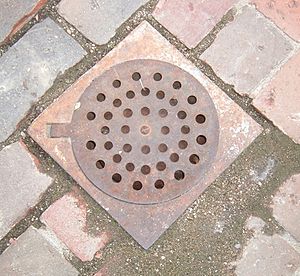Drain facts for kids
A drain is a special channel or pipe that helps move unwanted water away from places where it could cause problems. Think of it like a pathway for water. Drains are usually found in the ground or built into buildings. Their main job is to stop areas like streets, farmland, or even your home from getting flooded, especially when it rains a lot. They are a key part of how we manage water in our towns and cities.
Contents
What is a Drain?
A drain is essentially a system designed to collect and carry water. It can be a simple hole in the ground, a network of pipes, or a large underground tunnel. The goal is always the same: to direct water from one place to another, usually to a larger body of water like a river or a treatment plant. Without drains, rainwater would just sit on surfaces, making roads slippery and damaging buildings.
Why are Drains Important?
Drains play a super important role in our daily lives, even if we don't always see them.
- Preventing Floods: Their most crucial job is to stop flooding. When heavy rain falls, drains quickly move the water away, protecting homes, businesses, and roads.
- Keeping Us Safe: By removing standing water, drains help prevent accidents. Puddles can hide potholes or make surfaces slippery, which is dangerous for cars and people walking.
- Protecting Health: Stagnant water can become a breeding ground for mosquitoes and other pests that carry diseases. Drains help keep our environments healthier.
- Protecting Property: Water can cause a lot of damage to buildings, foundations, and gardens. Drains protect these structures by diverting water away.
Types of Drains
There are different kinds of drains, each designed for a specific purpose.
Storm Drains
Storm drains are built to handle rainwater. You often see their grates on the side of roads or in parking lots. When it rains, water flows into these grates and then through a system of pipes, usually leading to a river, lake, or ocean. This water is often not treated, so it's important not to dump pollution into storm drains.
Sanitary Drains
Sanitary drains are part of the sewer system. These drains carry wastewater from homes and buildings. This includes water from sinks, showers, toilets, and washing machines. Unlike storm drains, water in sanitary drains goes to a water treatment plant to be cleaned before it's released back into the environment.
French Drains
A French drain is a trench filled with gravel or rock, containing a perforated pipe. It's designed to direct surface water and groundwater away from an area. These are often used in gardens or around building foundations to prevent water from collecting and causing dampness. The pipe has small holes that allow water to seep in and then flow away.
How Do Drains Work?
Most drains work using gravity. Water naturally flows downhill. Engineers design drain systems with a slight slope, so water moves from higher points to lower points.
- Collection: Water first enters the drain system through inlets, grates, or channels.
- Conveyance: Once inside, the water travels through pipes or open channels. These pipes can be made of various materials like concrete, plastic, or metal.
- Discharge: Finally, the water is released at a designated outflow point. For storm drains, this might be a natural body of water. For sanitary drains, it's a treatment facility.
Keeping Drains Clean
For drains to work properly, they need to be kept clear of blockages.
- No Dumping: Never pour oil, chemicals, or trash down drains. These can clog the pipes and pollute the environment.
- Clear Grates: Leaves, litter, and debris can block storm drain grates. Keeping them clear helps water flow freely.
- Proper Disposal: For sanitary drains, avoid flushing things like wet wipes, paper towels, or food scraps. These items can cause major clogs in the sewer system.
- Regular Maintenance: Sometimes, professional cleaning is needed to remove stubborn blockages or inspect the drain system.
Drains are a vital part of our infrastructure, working silently to keep our communities safe and dry.


